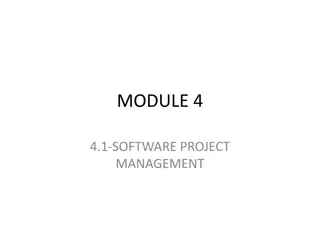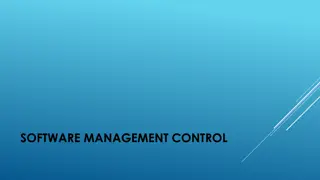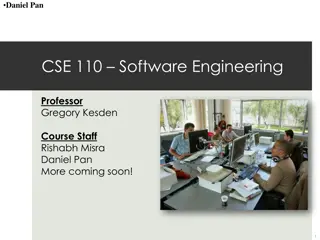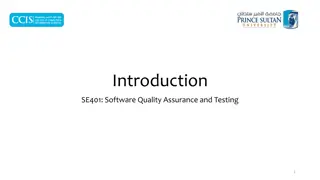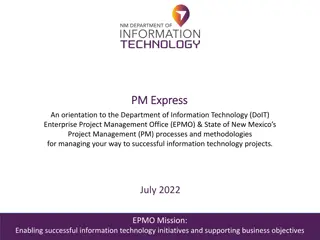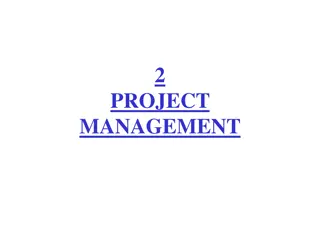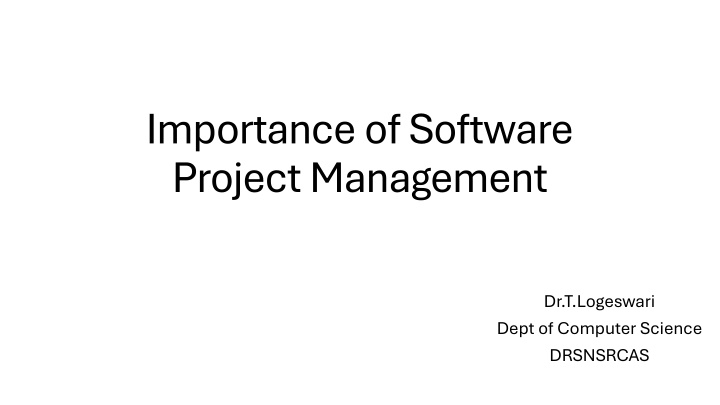
Importance of Software Project Management in Ensuring Success
Software project management is crucial for efficient resource allocation, clear communication, risk mitigation, scope control, quality assurance, and stakeholder satisfaction. It involves activities like project planning, scope management, and estimation, ensuring timely delivery of projects.
Download Presentation

Please find below an Image/Link to download the presentation.
The content on the website is provided AS IS for your information and personal use only. It may not be sold, licensed, or shared on other websites without obtaining consent from the author. If you encounter any issues during the download, it is possible that the publisher has removed the file from their server.
You are allowed to download the files provided on this website for personal or commercial use, subject to the condition that they are used lawfully. All files are the property of their respective owners.
The content on the website is provided AS IS for your information and personal use only. It may not be sold, licensed, or shared on other websites without obtaining consent from the author.
E N D
Presentation Transcript
Importance of Software Project Management Dr.T.Logeswari Dept of Computer Science DRSNSRCAS
Software project management plays a pivotal role in the success of software development endeavors. It is a discipline that ensures the following: Efficient Resource Allocation: Proper management of resources, including human resources, finances, time, and technology, helps optimize their utilization, leading to cost-effective and timely project delivery. Clear Communication: Software project management fosters transparent communication channels among team members, stakeholders, and clients. This clarity prevents misunderstandings, promotes alignment, and reduces the likelihood of errors. Risk Mitigation: Identifying and addressing potential risks early in the project lifecycle helps minimize their impact and ensure that projects stay on track despite unforeseen challenges.
Scope Control: Defining and managing project scope prevents scope creep, ensuring that the project stays focused on its objectives and doesn't deviate unnecessarily, which can lead to time and cost overruns. Quality Assurance: Effective software project management includes quality assurance and testing processes, guaranteeing that the software meets the defined standards and fulfills user requirements. Stakeholder Satisfaction: Involving stakeholders throughout the project makes their expectations and needs more likely to be met, resulting in higher satisfaction levels.
Timely Delivery: Through proper scheduling and monitoring, software project management ensures that projects are completed successfully on time, meeting critical deadlines. Activities Methodologies Software Project Management consists of many activities, that includes planning of the project, deciding the scope of product, estimation of cost in different terms, scheduling of tasks, etc. The list of activities are as follows: 1. Project planning and Tracking 2. Project Resource Management 3. Scope Management 4. Estimation Management
5. Project Risk Management 6. Scheduling Management 7. Project Communication Management 8. Configuration Manage ment 1. Project Planning: It is a set of multiple processes, or we can say that it a task that performed before the construction of the product starts. 2. Scope Management: It describes the scope of the project. Scope management is important because it clearly defines what would do and what would not. Scope Management create the project to contain restricted and quantitative tasks, which may merely be documented and successively avoids price and time overrun.
3. Estimation management: This is not only about cost estimation because whenever we start to develop software, but we also figure out their size(line of code), efforts, time as well as cost. If we talk about the size, then Line of code depends upon user or software requirement. If we talk about effort, we should know about the size of the software, because based on the size we can quickly estimate how big team required to produce the software. If we talk about time, when size and efforts are estimated, the time required to develop the software can easily determine.
And if we talk about cost, it includes all the elements such as: o Size of software o Quality o Hardware o Communication o Training o Additional Software and tools o Skilled manpower
4. Scheduling Management: Scheduling Management in software refers to all the activities to complete in the specified order and within time slotted to each activity. Project managers define multiple tasks and arrange them keeping various factors in mind. For scheduling, it is compulsory - o Find out multiple tasks and correlate them. o Divide time into units. o Assign the respective number of work-units for every job. o Calculate the total time from start to finish. o Break down the project into modules.
5. Project Resource Management: In software Development, all the elements are referred to as resources for the project. It can be a human resource, productive tools, and libraries. Resource management includes: o Create a project team and assign responsibilities to every team member o Developing a resource plan is derived from the project plan. Adjustment of resources.
6. Project Risk Management: Risk management consists of all the activities like identification, analyzing and preparing the plan for predictable and unpredictable risk in the project. Several points show the risks in the project: The Experienced team leaves the project, and the new team joins it. Changes in requirement. Change in technologies and the environment. Market competition.
7. Project Communication Management: Communication is an essential factor in the success of the project. It is a bridge between client, organization, team members and as well as other stakeholders of the project such as hardware suppliers. From the planning to closure, communication plays a vital role. In all the phases, communication must be clear and understood. Miscommunication can create a big blunder in the project. 8. Project Configuration management is about to control the changes in software like requirements, design, and development of the product. Management: Configuration
The Primary goal is to increase productivity with fewer errors. Some reasons show the need for configuration management: o Several people work on software that is continually update. o Help to build coordination among suppliers. o Changes in requirement, budget, schedule need to accommodate. o Software should run on multiple systems. Tasks perform in Configuration management: o Identification o Baseline o Change Control o Configuration StatusAccounting o ConfigurationAudits and Reviews
Categorization of Software Projects In project management, there are many categories that need to plan as well while planning the project. You will see each category in detail that how we can define the categories of the project. You will see categories like scope and significance, type of the project, level of technology, size, and scale of operations, ownership, and control, implementations, and purpose of the project are generally used categories. If you re planning a project and want to implement, then you can consider these categories. Projects are often categorized on the basis of their scope, size, speed of implementation, location, type, and technology.
The project can be classified on the grounds of the following.
Scope and Significance : The projects are generally classified on the basis of coverage and magnitude of their operations. So on the basis of scope projects can be National or International. National Projects There are also projects which are undertaken either by the government itself or assigned to private entrepreneurs in a country. In a country like India Public and Private sectors coexist to undertake major and minor projects. Government projects and private projects operate in vastly different environments, associated with different advantages and disadvantages. The only purpose of the National Project is the growth and development of the economy and maintenance of existing standards of living.
International Projects The projects which are embarked on by Foreign investors either by establishing a solitary or a branch of their unit or by mere participation in the equity of any domestic company are called International Projects. These can be in the form of joint ventures, MNC s, and collaborations between two companies. Type According to the type, projects can be industrial and non-industrial. Industrial These are those projects which are undertaken with a view to developing the economy. Non-Industrial These projects can be related to welfare and maintenance of a standard of living in an economy.
Level of Technology : Technology plays a significant role in managing projects. Projects can be sub- divided into four categories on the basis of technology. These are as follows. Conventional Technology Projects These are the projects which use acquainted and known technology in the continuous process. e.g. steel, cement, sugar, chemicals, and fertilizers, etc. Non-Conventional Technology Such kinds of projects apply if not the latest at least contemporary mode technology e.g. projects using cranes i.e. a mechanical way of lifting. High-Tech Project Huge investments are made in technology in these types of projects, e.g., space projects, nuclear power projects, etc. Low Investment Projects These types of projects demand low investment in technology e.g., cosmetics and household utilities, etc.
Size and Scale of Operations : On the basis of size and scale of operations, projects can be large scale, medium scale, and small scale. Small Scale Projects These are the projects which can be completed within a time period of 1-2 years and with investment below Rs. 5 crores. Medium Scale Projects These are the projects which can be completed within a time period of 2-5 years and with investment between Rs. 5 to Rs. 10 crores. Large Scale Projects These are the projects which can be completed within a time period of 5-10 years and with investment over and above Rs. 100 crores.
Ownership and Control : Projects can be divided into 3 categories according to their governance. Public Sector Projects These are fully owned and controlled by the government e.g., generating power and extracting minerals, etc. Private Sector Projects These are fully owned by individuals and companies e.g., newspapers and magazines, etc. Joint Sector Projects These projects are run and controlled by both government and private individuals are under this category.
Speed of Implementation : According to the speed of implementation, projects can be normal, crash, and disaster projects. Normal Projects In this category, an adequate time is allowed for implementation. It requires minimal capital costs. Crash Projects In this category, additional capital is incurred to save time. Disaster Projects In this category, naturally capital cost will go up, but project time will get drastically reduced. Failure of quality is accepted.
Purpose : There is always a purpose for everything. So, the projects are classified according to purpose as follows. Rehabilitation Projects These projects are undertaken by financially sound investing groups to service sick units. It is very risk and success are very less in such projects. Balancing Projects These are undertaken to cope with changes in the supply side of economies of factors of production, to eliminate the underutilization of the actual capacities, and enhance efficiency and effectiveness. Maintenance Projects These projects involve overhauling the machinery, repairs, and patching up activities at regular intervals. Modernization Projects Modernization of old plants is required to cope with the dynamic environment.
Others : Some other types of projects are as follows. Capacity Expansion Projects This involves enlarging the existing capacity of the products. Employees Welfare Project The objective of such projects is to install infrastructural facilities for improving working conditions and labor relations as well as to develop the skills of the staff.
Setting Objectives 1. Performance and Quality The end result of a project must fit the purpose for which it was intended. At one time, quality was seen as the responsibility of the quality control department. In more recent years the concept of total quality management has come to the fore, with the responsibility for quality shared by all staff from top management downwards.
2. Budget The project must be completed without exceeding the authorized expenditure. Financial sources are not always inexhaustible and a project might be abandoned altogether if funds run out before completion. If that was to happen, the money and effort invested in the project would be forfeited and written off. In extreme cases the project contractor could face ruin. There are many projects where there is no direct profit motive, however it is still important to pay proper attention to the cost budgets, and financial management remains essential.
3. Time to Completion Actual progress has to match or beat planned progress. All significant stages of the project must take place no later than their specified dates, to result in total completion on or before the planned finish date.
Management Principles The principles of project management are the fundamental rules that should be followed for the successful management of projects. For a successful project, the following project management principles are necessary assets when charting a path to completion.
Project structure Definition phase Clear goals Transparency about project status Risk recognition Managing project disturbances Responsibility of the project manager Project success
Project Structure Project management typically revolves around three parameters Quality, Resources, and Time. A project structure can usually be successfully created by considering: 1. Project Goal An answer to the question What has to be done is usually a good starting point when setting a project goal. This question leads to the project structure plan. 2. Project Timeline and Order A flowchart is a powerful tool to visualize the starting point, the endpoint, and the order of work packages in a single chart. 3. Project Milestones Milestones define certain phases of your project and the corresponding costs and results. Milestones represent decisive steps during the project.
Definition Phase The definition phase is where many projects go wrong. This can happen when no clear definition, or when the definition is muddled due to the involvement of too many stakeholders. A successful definition must involve the entire team at every step to facilitate acceptance and commitment to the project. Clear Goals The project manager is responsible for the achievement of all project goals. These goals should always be defined using the SMART paradigm (specific, measurable, ambitious, realistic, time-bound).
Transparency About the Project Status Your flowcharts, structure plan, and milestone plan are useful tools to help you stay on track. As a project manager, At such meetings, you should be able to give overviews about the costs, the timeline, and the achieved milestones. Risk Recognition It s the duty of the project manager to evaluate risks regularly.
Managing Project Disturbances It s not very likely that you have enough personal capacity to identify every single risk that may occur. Instead, work to identify the big risks and develop specific strategies to avoid them.
Responsibility of the Project Manager To develops the Project Plan with the team and manages the team s performance of project tasks. He also responsible for securing acceptance and approval of deliverables from the Project Sponsor and Stakeholders. It is responsible for communication, including status reporting, risk management, and escalation of issues that cannot be resolved in the team and generally ensuring the project is delivered within budget, on schedule, and within scope.
Project managers of all projects must possess the following attributes along with the other project-related responsibilities: Knowledge of technology in relation to project products Understanding Management concepts Interpersonal skills for clear communications that help get things done Ability to see the project as an open system and understand the external-internal interactions
Project Success Project success is a multi-dimensional construct that can mean different things to different people. Management Control Management control in software project management refers to the processes, tools, and techniques used to monitor, measure, and regulate various aspects of a software development project to ensure that it stays on track, meets its objectives, and delivers high-quality results.
Effective management control consist of several key elements: Planning Project Planning: Develop a comprehensive project plan that outlines the scope, objectives, schedule, resources, and budget. Risk Management: Identify potential risks & Establish risk mitigation strategies and contingency plans to address potential issues Monitoring and Measurement: Performance Metrics: Define key performance indicators (KPIs) to measure the project's progress and success. Progress Tracking: Regularly monitor and track project progress against the established baseline.. Quality Assurance: Implement processes for ensuring the quality of the software being developed. This includes code reviews, testing procedures, and adherence to coding standards.
Resource Management: Resource Allocation: Ensure that the right people with the necessary skills are assigned to specific tasks. Budget Control: Keep a close eye on project expenditures and make sure they align with the budget. Communication: Stakeholder Communication: Maintain open and transparent communication with stakeholders, Issue Resolution: Establish a process for identifying and resolving issues as they arise. Promptly address any roadblocks that could hinder progress.
Change Management: Change Control: Implement a formalized process for handling changes to project scope, requirements, or other elements Documentation: Keep comprehensive documentation of project decisions, changes, and the rationale behind them. Feedback and Improvement: Post-Implementation Review: Conduct a thorough review of the project after completion to identify lessons learned, successes, and areas for improvement. Continuous Improvement: Encourage a culture of continuous improvement within the project team. Regularly review and update project management processes based on feedback and evolving best practices.
Project Portfolio Management Project portfolio management (PPM) is the centralized management of an organization's projects. projects may or may not be related, they are managed under one umbrella (called a portfolio). It also involves the intake process of projects. This includes identifying potential projects, authorizing them, assigning project managers, and including them in the overall portfolio.
The five steps of project portfolio management 1. Identify the guiding objectives of the business If you work for a grocery store, is their goal to provide the freshest food, the largest selection, or the lowest prices? If the lowest prices are the priority, then projects to promote cost savings are much more important than projects to improve the food's quality. 2. Capture and research requests and ideas Project ideas could come from anywhere at any time. This may be as simple as a spreadsheet maintained by the portfolio manager, or it could be an online database where anyone in the company can enter ideas as they think of them.
3. Select the best projects Once ideas are captured, portfolio managers must go through a standard process to evaluate and select the projects that will move forward. This requires more than just ensuring they are aligned with the company objectives, such as: How much will it cost? How long will it take? Validate portfolio feasibility and initiate projects Once a determination has been made on which projects to move forward, it's important to validate the portfolio as a whole. This can include making sure the mix of projects chosen isn't too large, too risky, too expensive, or too interdependent. The portfolio should be properly balanced and aligned with business goals..
5. Manage and monitor the portfolio Projects change and evolve over time, and new ideas may be added to the list of potential projects. Identifying and resolving conflicts between projects Making changes to the portfolio as needed, including putting projects on hold, canceling projects, and adding in new projects Ensuring projects are still aligned with the business objectives
Cost-Benefit Evaluation Technology A cost-benefit analysis (CBA), sometimes referred to as benefit-cost analysis (BCA), makes it clear what projects or investments are most viable, possible, and beneficial for an organization at any given time. A cost-benefit analysis in project management is a tool to evaluate the costs vs. benefits of an important project or business proposal. It is a practical, data-driven approach for guiding organizations and managers in making solid investment decisions. It helps determine if a project or investment is financially feasible and beneficial for the organization
In a CBA, costs may include the following: Direct costs: These are costs that are directly related to the proposed project or investment, e.g., materials, labor, and equipment. Indirect costs: These are related fixed costs that contribute to bringing the project or investment to life, e.g., overhead, administrative, or training expenses. Opportunity costs: These are the benefits or opportunities foregone when a business chooses one project or opportunity over others. Future costs: These are costs that may come up later in the project. These costs depend on certain factors happening, e.g., costs of mitigating potential risks. Cost-benefit analysis facilitates a structured cost management process, helping project managers and company executives prioritize projects and allocate resources effectively to achieve the organization s main goals.
Conducting a project cost-benefit analysis helps to: Identify project costs and benefits Provide a framework for analysis: Make better-informed decisions Promote transparency Facilitate communication
Risk Evaluation Risk is associated with almost every project. Risk can become an important factor when the project is not able to meet its objectives. Every possible risk must be identified, analyzed and minimized during the development of the software system. Risk Identification Every project evaluation involves risk handling issues. All possible risks are identified and must be quantified with their potential measures of evaluation. A project risk matrix can be implemented in creating a checklist of all possible risks and classify them based on their relative importance. The risk matrix contains values of high, medium and low based on their likelihood. Some factors classified in the risk project matrix contains, delivery of software, development budget exceeded limit, estimation of maintenance costs, response time targets and so on.
Risk Ranking Based on the risk identified, ranking can be established for projects. Evaluating projects based on the risk project matrix gives a clear picture of how to rank the different risks that occurs in projects. Risk ranking involves giving scores to projects based on priorities defined for each risk in the project. Risk Profile Analysis Risk profiles are constructed using sensitivity analysis which involves the sensitivity factors that affect the project costs or benefits. Risk handling using Decision trees It is better to reject projects than working with risky ones. Decision trees is a tool which provides evaluation of project s expected outcomes and choosing between the alternative strategies
Strategic Program Management A classical definition of programme management by D.C.Ferns, a group of projects that are maintained in a coordinated way to gain benefits that would not be possible where the projects to be managed independently . Different forms of Programme Management There are various forms of programme management exists. They are Strategic programmes Business cycle programmes Infrastructure programmes Research and development programmes
1. Strategic Programmes Portfolio programme models define a strategic domain process within the organization. Group of projects can lead to single strategy. Organizations can be grouped together and every activity associated with each distinct project can be controlled and coordinated manner as a programme Strategic Programme Management A programme manager must possess these qualities: Managing simultaneous projects inside the portfolio Resources must be well understood Utilization of resources must be attained Optimal usage of specialist staff for specific tasks
2. Business Cycle Programmes A project portfolio is a group of projects carried out under the sponsorship or management of an organization. Prioritizing projects must be based on decisions made by the project manager to handle them in different situations. If one project needs more resources than expected, expenses can be incorporated fro mother projects giving preference to the former one. Importance must be given to individual projects inside the portfolio 3. Infrastructure Programmes Organizations differ in the way they exist. Some of them have distinct departments while others have integrated systems. Each department might be unique in handling different information having distinct databases defined. A uniform infrastructure will allow sharing of applications between various departments which would help in the development process
4. Research and Development Programmes Innovative companies develop new products that are too risky. If the new product fails in the market, it will be difficult to handle the situation. On the other hand, the new product becomes success, then there will be huge reap in the business organization. Certain development projects results in a good planned project. But projects that are too risky if successful yields more benefit than the innovative ones.


